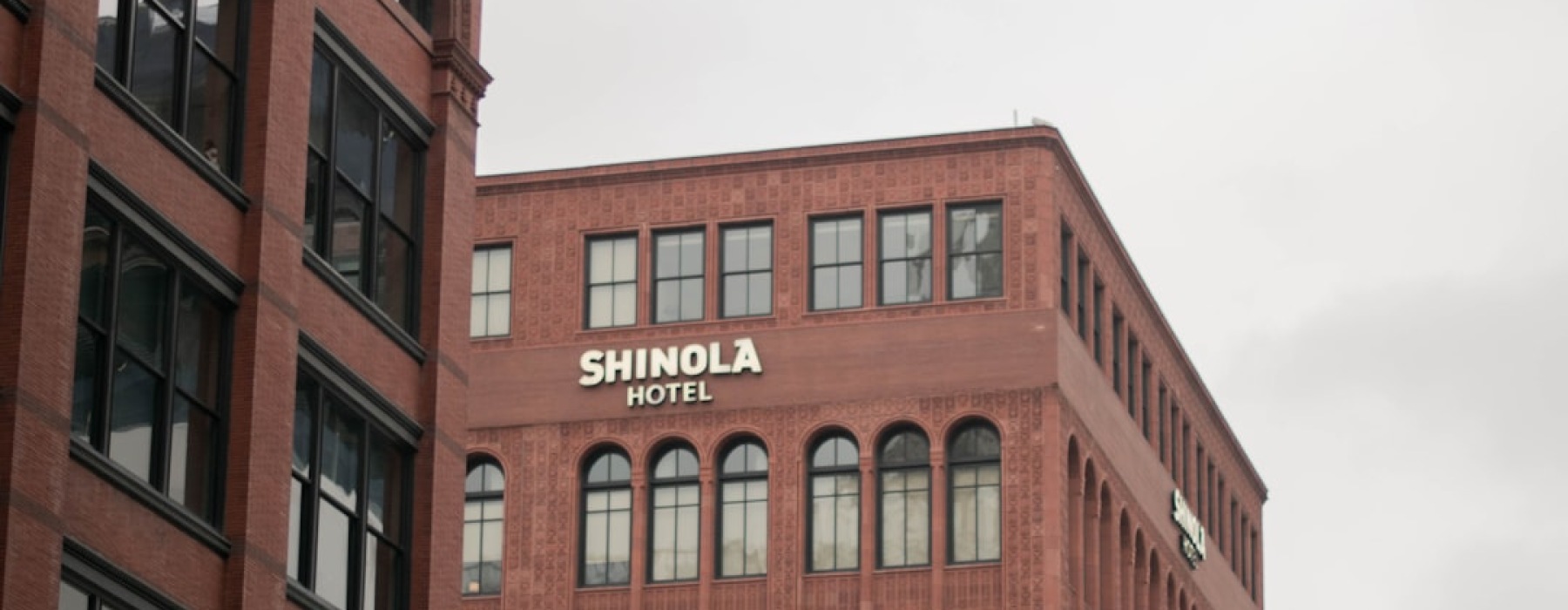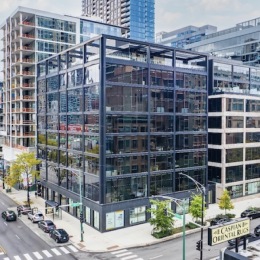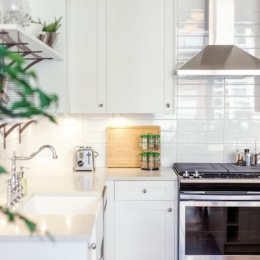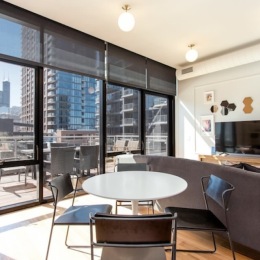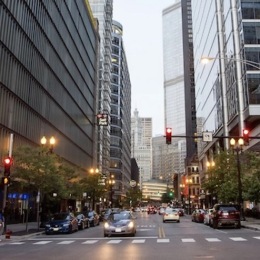Why Warehouse-Style Apartments Are Taking Over Chicago's Rental Market
Warehouse-style apartments Chicago offer a unique blend of industrial charm and modern living that's attracting urban professionals across the city. These converted spaces feature the raw architectural elements of their industrial past—exposed brick walls, soaring ceilings, and massive factory windows—while providing all the amenities today's renters expect.
Key Features of Chicago Warehouse-Style Apartments:
- High ceilings: Typically 14-17 feet tall
- Exposed elements: Brick walls, timber beams, and industrial ductwork
- Large windows: Floor-to-ceiling factory-style glass
- Open layouts: Flexible floor plans with minimal interior walls
- Prime locations: Concentrated in West Loop, Fulton Market, River North, and South Loop
- Modern amenities: In-unit laundry, fitness centers, rooftop decks
Currently, 945 loft apartments are available for rent across Chicago, with these converted industrial spaces clustering in neighborhoods where manufacturing once thrived. The city's warehouse-to-residence conversion trend has transformed former factories, shipping warehouses, and department store buildings into some of the most sought-after rental properties in the market.
"Think outside the white box in the sky" is how one converted Marshall Field's warehouse markets itself—and that captures exactly why these spaces appeal to renters seeking something different from cookie-cutter apartment living.
The distinction between hard lofts (authentic warehouse conversions), soft lofts (new construction with loft-style features), and timber lofts (featuring exposed wood beams) gives renters multiple options for experiencing this industrial-chic lifestyle.
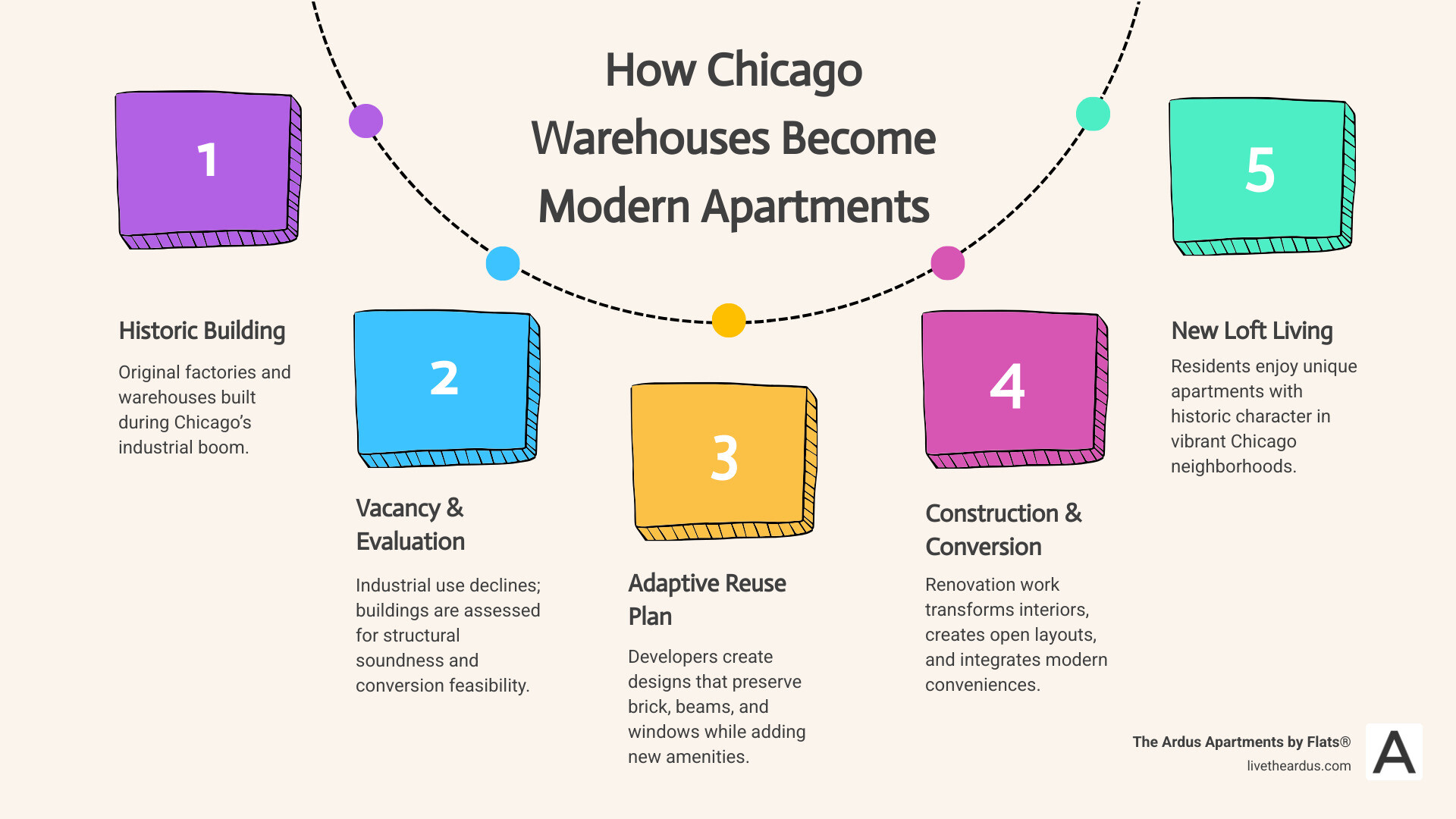
What Makes Warehouse-Style Apartments Stand Out?
The appeal of warehouse-style apartments lies in their ability to preserve Chicago's industrial heritage while meeting modern living standards. These spaces offer something you simply can't find in traditional apartment buildings—character that comes from decades of history embedded in every brick and beam.
Exposed brick walls serve as natural artwork, creating texture and warmth that no paint color can replicate. The soaring ceilings, often reaching 14-17 feet, make even smaller floor plans feel expansive and airy. Factory windows, originally designed to flood industrial workspaces with natural light, now illuminate living spaces with the kind of brightness that makes morning coffee feel like a luxury experience.
The open footprints that made these buildings efficient for manufacturing now provide best flexibility for modern living. We can arrange furniture to create distinct zones—a living area here, a home office there—without feeling confined by traditional room layouts. This adaptive reuse approach means no two warehouse apartments are exactly alike, each maintaining unique architectural quirks from its industrial past.
What truly sets these spaces apart is their ability to tell a story. Living in a converted Marshall Field's warehouse means sharing space with Chicago's retail history. A former shipping warehouse connects residents to the city's role as a transportation hub. These aren't just apartments—they're pieces of Chicago's industrial legacy transformed for contemporary life.
Key Architectural Elements in warehouse-style apartments Chicago
Warehouse-style apartments Chicago showcase distinct architectural features that separate them from standard residential buildings. Understanding these elements helps renters appreciate what makes each space unique and functional.
Timber beams, often original to the building's industrial use, create visual interest on ceilings while serving as structural elements. These exposed wooden supports add warmth to otherwise industrial spaces and provide natural dividers in open floor plans. Some buildings feature concrete columns that once supported heavy machinery, now serving as dramatic focal points in living areas.
Exposed ductwork, rather than being hidden behind dropped ceilings, becomes part of the aesthetic. This industrial element maintains the authentic feel while providing practical HVAC distribution throughout the space. The combination of exposed brick, timber, and metal creates a material palette that's both rustic and sophisticated.
Comparison of Loft Types:
| Feature | Hard Lofts | Soft Lofts | Timber Lofts | Traditional Apartments |
|---|---|---|---|---|
| Origin | Converted warehouses | New construction | Wood-beam buildings | Purpose-built residential |
| Ceiling Height | 14-17 feet | 10-14 feet | 12-16 feet | 8-10 feet |
| Exposed Elements | Brick, beams, ductwork | Designed to mimic industrial | Timber beams, brick | Minimal exposed elements |
| Floor Plans | Completely open | Open with some walls | Semi-open layouts | Traditional room divisions |
| Windows | Large factory-style | Floor-to-ceiling modern | Mixed industrial/residential | Standard residential |
| Character Level | Highest authenticity | Modern interpretation | Moderate authenticity | Minimal industrial character |
The beauty of these architectural elements lies in their functionality. High ceilings improve air circulation and create a sense of grandeur. Large windows reduce the need for artificial lighting during the day. Open layouts allow for personalized space planning that changes with lifestyle needs.
Where to Look: Chicago Neighborhoods & Landmark Conversions
Chicago's warehouse-style apartment scene clusters in neighborhoods where industry once thrived, creating distinct pockets of loft living across the city. Each area offers its own character and amenities while maintaining the industrial aesthetic that defines this housing style.
The West Loop stands as the epicenter of Chicago's warehouse conversion movement. Former meatpacking plants and distribution centers have transformed into luxury loft buildings, surrounded by some of the city's best restaurants and nightlife. The neighborhood's proximity to the Loop makes it ideal for professionals working downtown, while its industrial heritage provides authentic warehouse conversions.
Fulton Market, once Chicago's wholesale food district, now hosts a concentration of warehouse-style apartments alongside tech companies and trendy restaurants. The area's brick-lined streets and converted food processing buildings create an authentic industrial atmosphere that appeals to renters seeking both character and convenience.
River North offers a mix of converted warehouses and new construction designed to mimic loft aesthetics. The neighborhood's proximity to Navy Pier, the Magnificent Mile, and downtown employment centers makes it particularly attractive to urban professionals. Many of the area's warehouse conversions feature stunning city and lake views from their upper floors.

South Loop warehouse conversions often feature proximity to Grant Park, Museum Campus, and major transportation hubs. The area's former printing and manufacturing buildings have been transformed into loft communities that blend historical character with modern amenities.
Logan Square and Noble Square represent more emerging areas for warehouse-style living. These neighborhoods offer converted industrial buildings at different price points, often featuring unique architectural details and community-focused amenities.
For those specifically interested in River North options, More info about River North lofts provides detailed insights into this popular neighborhood's loft market.
Notable Buildings Every Loft Hunter Should Know
Several landmark warehouse conversions have become icons of Chicago's loft living scene, each offering unique features that showcase different approaches to adaptive reuse.
The Field's Lofts at Logan Square represents a prime example of department store warehouse conversion. Originally serving Marshall Field's luxury retail operation, this building maintains its commercial heritage while offering modern amenities like co-working spaces, fitness centers, and rooftop decks. The 14-17 foot ceilings and large industrial windows create dramatic living spaces that honor the building's retail legacy.
Cobbler Square in Old Town demonstrates how smaller industrial buildings can be transformed into intimate loft communities. The complex's brick courtyards and converted workshop spaces create a village-like atmosphere within the urban environment. Residents enjoy proximity to dining, entertainment, and public transportation while living in spaces that showcase traditional craftsmanship.
Lofts at River East showcases the potential of shipping warehouse conversions. Originally built in the 1900s to support Chicago's booming shipping industry, this 285-unit building offers 74+ different floor plans, ensuring each residence feels unique. The building's waterfront location provides stunning city and lake views, while amenities like a screening room and Peloton spin classes cater to modern lifestyle needs.
For a virtual exploration of this iconic building, the Lofts At River East virtual tour provides an immersive look at the space and layout options available.
1720 North Halsted represents the timber loft category, featuring exposed wood beams and brick walls that create a warmer, more residential feel than pure industrial conversions. The building's smaller scale and neighborhood setting appeal to renters seeking loft character without the intensity of downtown living.
Lofts at Gin Alley in Fulton Market exemplifies modern luxury warehouse conversions. The building combines authentic industrial elements with high-end finishes and comprehensive amenity packages. Its location in the heart of Fulton Market provides easy access to the neighborhood's dining and entertainment scene while maintaining the industrial aesthetic that defines the area.
Each of these buildings demonstrates different approaches to warehouse conversion, from preserving original architectural details to integrating modern amenities. They serve as examples of how Chicago's industrial heritage can be successfully adapted for contemporary living while maintaining the character that makes these spaces special.
Lifestyle Benefits & Modern Amenities
Living in warehouse-style apartments offers lifestyle advantages that extend far beyond their distinctive architectural features. The combination of historical character and modern conveniences creates living experiences that traditional apartments simply cannot match.
Natural light floods these spaces through oversized factory windows, reducing dependence on artificial lighting and creating bright, energizing environments throughout the day. The large windows also provide impressive views of Chicago's skyline, lakefront, or neighborhood streetscapes, making every day feel more connected to the city's energy.
Flexible layouts accommodate changing lifestyle needs without requiring a move. The open floor plans allow residents to reconfigure spaces for work-from-home setups, entertaining, or simply changing aesthetic preferences. A dining area can become a home office, or a corner can transform into a yoga studio—the possibilities adapt to life's evolving demands.
Modern warehouse conversions integrate amenities that improve urban living. Rooftop lounges provide outdoor space with panoramic city views, perfect for morning coffee or evening gatherings. Co-working hubs cater to remote workers and entrepreneurs who need professional spaces without leaving home. State-of-the-art fitness centers eliminate the need for expensive gym memberships while providing convenient access to exercise equipment.
Many buildings feature specialized amenities that reflect their industrial heritage. Bike storage facilities with maintenance stations cater to urban cyclists. Package lockers handle the increasing volume of online deliveries. Some conversions include on-site coffee shops, dry cleaning services, and even art programs that honor the building's history.
The two-pet limit common in many warehouse-style apartments accommodates urban pet owners who want to share their loft lifestyle with furry companions. Many buildings include pet-friendly amenities like washing stations, outdoor runs, and nearby park access.
Community spaces in warehouse conversions often feel more authentic than those in traditional apartment buildings. Common areas might feature original brick walls, exposed beams, or industrial fixtures that create gathering spaces with genuine character. These environments naturally encourage neighbor interactions and community building.
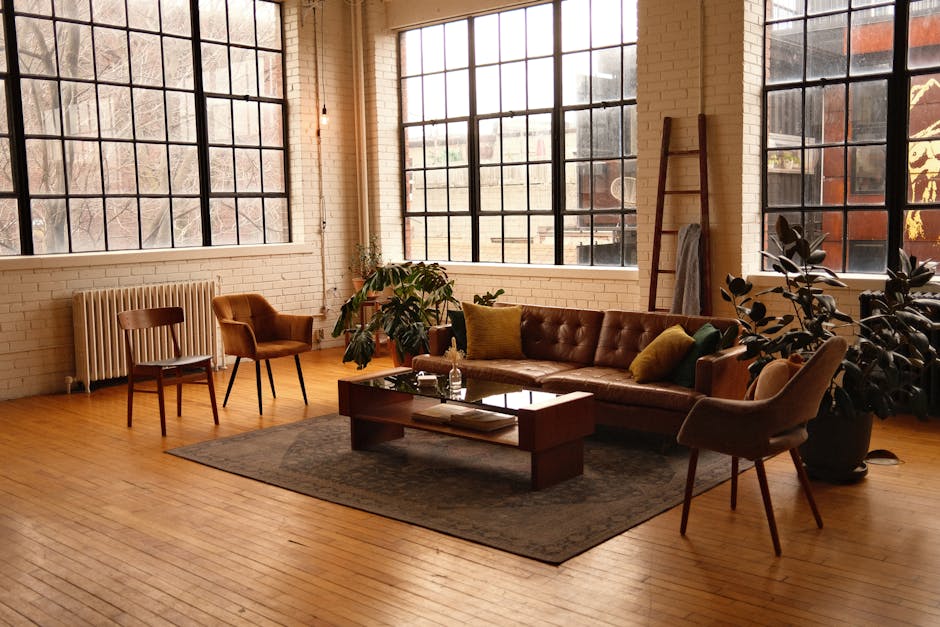
From Brick Walls to Smart Tech—Features You'll See in warehouse-style apartments Chicago
Warehouse-style apartments Chicago seamlessly blend historical architectural elements with cutting-edge modern conveniences, creating living spaces that honor the past while embracing contemporary technology and comfort.
In-unit laundry facilities have become standard in warehouse conversions, with full-size washers and dryers that accommodate the lifestyle needs of urban professionals. These aren't the compact, stackable units found in many traditional apartments, but full-capacity machines that handle everything from workout clothes to bulky comforters.
Stainless steel appliances create sleek kitchen environments that complement the industrial aesthetic. Modern refrigerators, ranges, and dishwashers provide contemporary functionality while maintaining the clean lines that work well with exposed brick and timber elements. Many units feature kitchen islands or breakfast bars that take advantage of the open floor plans.
Package lockers have become essential in warehouse buildings, where residents might receive multiple deliveries weekly. These secure systems, often featuring brands like Luxer One or Amazon Hub, provide 24/7 access to packages while maintaining building security. Some buildings include temperature-controlled lockers for grocery deliveries or sensitive items.
Climate control systems in warehouse conversions face unique challenges due to high ceilings and large windows. Modern HVAC systems are designed to efficiently heat and cool these spaces, often featuring zone controls that allow residents to customize temperatures in different areas of their open floor plans. Some buildings incorporate energy-efficient systems that take advantage of natural light and thermal mass from brick walls.
Smart entry systems provide keyless access through smartphone apps or key fobs, eliminating the need for traditional keys while enhancing security. These systems often integrate with building amenities, allowing residents to access fitness centers, rooftop decks, and package rooms with the same credentials.
High-speed internet infrastructure supports the work-from-home lifestyle common among warehouse apartment residents. Many buildings feature fiber optic connections and built-in WiFi in common areas, recognizing that reliable internet access is as essential as electricity or water for modern urban living.
Storage solutions address the challenge of organizing belongings in open floor plans. Built-in closet systems, under-stair storage, and creative use of vertical space help residents maximize their square footage while maintaining the uncluttered aesthetic that makes warehouse living appealing.
How to Find & Tour Your Future Loft
Finding the perfect warehouse-style apartment requires a strategic approach that takes advantage of both traditional and modern search methods. The unique nature of these spaces means that standard apartment hunting techniques need to be adapted for the loft market.
Virtual walkthroughs have become particularly valuable for warehouse apartments, where the scale and character of spaces can be difficult to convey through standard photos. Many buildings offer 360-degree tours, 3D walkthroughs, and video tours that showcase the dramatic ceiling heights, exposed architectural elements, and natural light that define these spaces.
Self-guided tours provide flexibility for busy professionals who want to explore buildings on their own schedule. Many warehouse conversions offer app-based touring systems that allow prospective residents to access units during extended hours, providing a more relaxed environment for evaluating spaces and asking questions.
Leasing offices in warehouse buildings often reflect the industrial aesthetic of the apartments themselves, featuring exposed brick, high ceilings, and large windows. These spaces provide opportunities to experience the building's character while discussing floor plans, amenities, and lease terms with leasing professionals.
Map-based searches help identify warehouse-style apartments in preferred neighborhoods. Online platforms allow filtering by ceiling height, architectural features, and building age, making it easier to find authentic conversions versus new construction with loft-style features.
The concentration of warehouse apartments in specific neighborhoods means that visiting areas like West Loop, Fulton Market, or River North can provide opportunities to tour multiple buildings in a single day. Walking these neighborhoods also provides insight into the lifestyle and community that comes with warehouse living.
For those ready to begin their search, SCHEDULE A SHOWING provides access to available warehouse-style apartments with convenient online booking.
Many successful loft hunters recommend visiting buildings at different times of day to understand how natural light changes throughout the space. Morning tours showcase how factory windows flood apartments with sunrise light, while evening visits reveal how the spaces feel with artificial lighting and city views.
Renter Checklist: What to Consider Before Signing
Warehouse-style apartments present unique considerations that differ from traditional apartment hunting. Understanding these factors helps ensure that loft living meets expectations and lifestyle needs.
Sound insulation varies significantly between warehouse conversions. Original industrial buildings weren't designed with residential noise considerations, so understanding how sound travels between units and from common areas is crucial. Some buildings have invested in additional soundproofing during conversion, while others maintain the original acoustic properties that can transmit sound between spaces.
Window orientation affects both natural light and temperature control throughout the day. South-facing windows provide maximum light but can create heat challenges in summer. North-facing windows offer consistent, softer light but may require more artificial lighting. East and west orientations provide dramatic sunrise or sunset views but can create glare at certain times of day.
Storage solutions require creative thinking in open floor plans. Evaluating built-in storage, closet space, and opportunities for adding furniture-based storage helps determine if a space can accommodate belongings without feeling cluttered. Some warehouse apartments include additional storage lockers in basements or common areas.
Parking solutions vary widely between buildings and neighborhoods. Some warehouse conversions include attached or nearby parking structures, while others rely on street parking or separate rental arrangements. Understanding parking options and costs helps avoid surprises after moving in.
Building history provides insight into potential maintenance issues and architectural quirks. Understanding when a building was converted, what improvements have been made, and any ongoing renovation plans helps set appropriate expectations for living in a converted industrial space.
Lease flexibility becomes important for renters who may need to modify their space for changing work or lifestyle needs. Some buildings allow minor modifications like adding temporary walls or installing additional lighting, while others maintain strict policies about alterations.
Utility costs in warehouse apartments can differ from traditional apartments due to high ceilings, large windows, and open floor plans. Understanding what utilities are included in rent and estimated costs for others helps with budgeting and comparison shopping between properties.
For additional insights into modern living options in Chicago, More info about modern living in Chicago provides comprehensive guidance on urban apartment living.
Frequently Asked Questions about Warehouse-Style Apartments Chicago
What's the difference between hard, soft, and timber lofts?
Hard lofts represent authentic warehouse conversions from buildings that previously served industrial purposes. These spaces feature original architectural elements like exposed brick walls, concrete floors, steel beams, and large factory windows. Hard lofts often have the most character and historical authenticity, with ceiling heights typically ranging from 14-17 feet and completely open floor plans.
Soft lofts are newly constructed buildings designed to mimic the industrial aesthetic of warehouse conversions. These spaces feature modern amenities and updated building systems while incorporating design elements like exposed ductwork, concrete floors, and high ceilings. Soft lofts often provide more consistent layouts and modern conveniences while maintaining the visual appeal of industrial design.
Timber lofts fall between hard and soft lofts, typically featuring exposed wood beams as their primary architectural element. These conversions often come from buildings that used heavy timber construction, creating warmer, more residential-feeling spaces than pure industrial conversions. Timber lofts may include exposed brick walls combined with wooden structural elements.
Are warehouse-style apartments pet-friendly?
Most warehouse-style apartments in Chicago welcome pets, with many buildings allowing up to two pets per unit. The open floor plans and high ceilings of warehouse apartments actually provide excellent living environments for pets, offering plenty of space for movement and play.
Many warehouse conversions include pet-friendly amenities like on-site washing stations, outdoor dog runs, and nearby park access. The industrial aesthetic of these buildings often incorporates pet-friendly materials like concrete floors and brick walls that can withstand pet-related wear and tear.
Pet policies vary between buildings, with some including breed restrictions and others focusing on size limits. Most warehouse apartments charge pet fees and monthly pet rent, with typical costs including one-time fees and ongoing monthly charges per animal.
Are these apartments a good fit for families, singles, or couples?
Warehouse-style apartments accommodate various household types, though they're particularly well-suited for certain lifestyles and preferences.
Singles often appreciate the flexibility of open floor plans that can be configured for work, entertainment, and relaxation without feeling cramped. The dramatic architectural elements and urban locations appeal to young professionals who want distinctive living spaces that reflect their personal style.
Couples find warehouse apartments ideal for shared living, with open layouts that promote togetherness while providing opportunities to create separate zones for individual activities. The high ceilings and large windows create spacious environments that don't feel confining even when sharing space.
Families can successfully live in warehouse-style apartments, particularly in larger floor plans with two or three bedrooms. The open layouts allow for creative space planning, and many buildings include family-friendly amenities like rooftop decks and community spaces. However, families should consider factors like sound transmission between units and the urban environment when evaluating warehouse living.
The key to success in warehouse-style apartments lies in appreciating the industrial aesthetic, embracing open floor plans, and taking advantage of the flexibility these spaces provide for creating personalized living environments.
Conclusion
Chicago's warehouse-style apartment market offers an unparalleled opportunity to live within the city's industrial heritage while enjoying modern conveniences and urban amenities. From the authentic exposed brick and soaring ceilings of converted Marshall Field's warehouses to the contemporary luxury of new construction with loft-inspired design, these spaces provide living experiences that traditional apartments simply cannot match.
The 945 loft apartments currently available across Chicago represent more than just housing options—they're gateways to a lifestyle that celebrates the city's manufacturing past while embracing its technological future. Whether you're drawn to the authentic character of hard lofts in Fulton Market, the refined luxury of River North conversions, or the emerging communities in Logan Square, warehouse-style living offers flexibility, character, and connection to Chicago's urban energy.
We've explored how these spaces blend historical architecture with modern amenities, from exposed timber beams and factory windows to smart home technology and rooftop lounges. The neighborhoods where these apartments cluster—West Loop, Fulton Market, River North, and South Loop—provide not just distinctive housing but access to Chicago's best dining, entertainment, and employment opportunities.
At The Ardus Apartments by Flats®, we understand the appeal of warehouse-style living and the unique lifestyle it provides. Our River North location exemplifies how former industrial spaces can be transformed into modern living environments that honor their heritage while meeting contemporary needs. Our rooftop lounge and on-site coffee shop create community spaces that reflect the authentic character our residents seek.
The journey from industrial building to modern home represents more than architectural conversion—it's about preserving Chicago's heritage while creating spaces for the city's future. Whether you're a young professional seeking your first downtown apartment, a couple looking for distinctive shared space, or anyone drawn to the character and flexibility of warehouse living, Chicago's loft market offers options that can transform your daily experience of urban life.
Ready to explore warehouse-style living in Chicago? Live the lifestyle you want and find how industrial heritage and modern comfort can create the perfect urban home.
